Bible Belt Has Most Sinners, Research Suggests: How Sinful is Your State?

A set of United States maps showing the counties that have the highest concentrations of sin, based on the "Seven Deadly Sins," has caused a stir since Memolition reposted it this month. In each of the maps the southeast, an area often referred to as the "Bible Belt" for its tradition of faith, has the largest amount of sin per capita.
"We compiled those maps from the standpoint of geographic information science," Mitch Stimers, who worked on the study as a graduate student at Kansas State University in 2009, told The Christian Post in an interview on Friday.
Now a director of institutional research and instructor of geography and geosciences at Cloud County Community College, Stimers insisted, "we weren't attempting to interject any moral interpretation into them."
Each of the seven sins – originally codified by Pope Gregory the Great in the sixth century – was measured by population research data, such as the total number of violent crimes reported to the FBI (wrath). On the maps, red areas have the highest concentration of sin, blue the least, and most sins pervade the Bible Belt.
"Those swaths of red through the South - people automatically interpret that as the Bible Belt being more sinful, but the proxies we used are well known to be correlated to lower income," Stimers explained.
The particular sin of greed has garnered the most attention recently, as it was measured by comparing average incomes with the total number of inhabitants living beneath the poverty live.
This measurement assumes that if incomes are vastly unequal in an area, that inequality must have been caused by greed. "It is commonly assumed that the rich are de facto greedy and that theft and corruption are their means to wealth accumulation. Thus, they view any income inequality as inherently unjust," Anne Bradley, vice president of Economic Initiatives at the Institute for Faith, Work, and Economics (IFWE), commented in a blog post on the Seven Deadly Sins report.
Income inequality, far from an indicator of vice, is a fundamental reality in a world where different people have different talents, Bradley and her fellow Christian scholars told CP earlier this week. "Greed is a heart issue, not an income issue," IFWE's Elise Amyx explained in the same blog post. She argued that these statistics do not reveal the true hearts of Americans, and cannot portray sin accurately.
Rudy Rasmus, founding pastor of St. John's Methodist Church in Houston, agreed that sin – and especially greed – is a matter of the heart, not statistics. In his article about the Seven Deadly Sins maps, Rasmus argued that greed is caused by scarcity.
"The major obstacle in today's world prohibiting the sharing of love is scarcity, inadequacy and insecurity," Rasmus wrote. Instead of worrying if they will have enough, Christians should embrace the presence of God and share His love with others. "Scarcity divides the moment; pure presence lets it be what it is, as it is," Rasmus declared.
The geographers note on the website, "Cardinal vices, cardinal sins, or more commonly, the seven deadly sins, have been discussed and debated since at least the fourth century." It also lists Pope Gregory I's list: luxuria (lust), gula( gluttony), avaritia (greed), acedia (sloth), ira (wrath), invidia (envy), and superbia (pride).
The researchers used the best data available to them – "sociologic and economic characteristics" – rather than the human heart. "Pride, the 'greatest' and 'root' of all sins, was determined to be the aggregation of each sin," the further website explains.
News also broke Friday that David Mamet, producer of The Unit, will produce a new TV short, "7 Deadly Sins" on Fox.
1. Lust
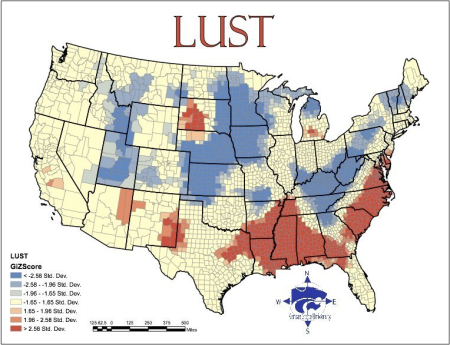
Lust, the craving for sex, was measured by counting the number of sexually transmitted diseases – HIV, AIDS, syphilis, chlamydia and gonorrhea, per person.
2. Gluttony
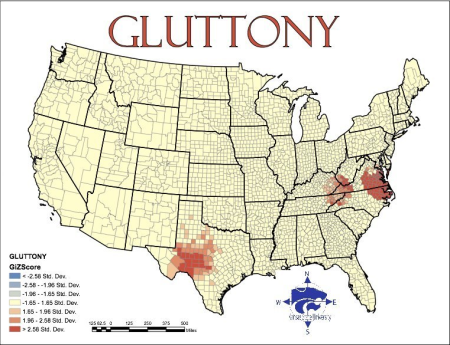
Gluttony, the desire to consume more than is right, was calculated by counting the number of fast food restaurants per person.
3. Greed
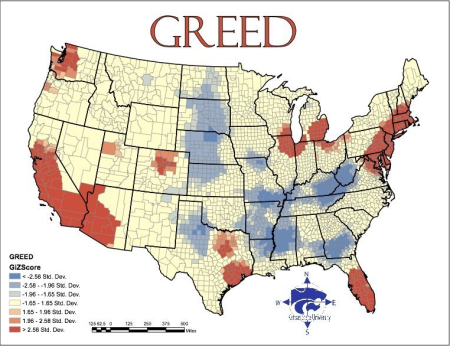
Greed, an excessive desire for material gain, was calculated by comparing average incomes with the number of people living beneath the poverty line.
4. Sloth

Sloth, the avoidance of work or pursuit of good things, was calculated by comparing the money spent on arts, entertainment and recreation to the employment rate.
5. Wrath
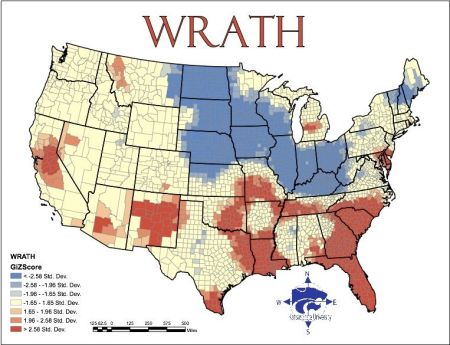
Wrath, the loss of self-control coupled with the desire to hurt others, was measured by comparing the number of violent crimes – murder, assault and rape – reported to the FBI.
6. Envy
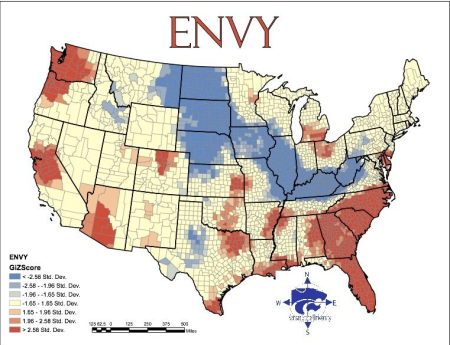
Envy, wanting what others have, was calculated using the total number of thefts – robbery, burglary, larceny and stolen cars.
7. Pride

Pride, excessive praise of oneself or the valuing of oneself over God, was calculated by combining the data for the other sins.






















